PHENOMENON
Black Holes: The Mysteries of Cosmic Abyss
By ayaan atif, ceo cosmoyage
October 9th, 2023
Black holes have always been super interesting to scientists and regular folks like you and me. These mysterious things in space really capture our imagination because they mark the limit of what we understand about the universe. In this article, we'll take a trip to discover the secrets of black holes, looking into how they form, what they're like, and the big effect they have on the way space and time work.
What Are Black Holes?
Black holes are places in space with incredibly strong gravity. It's so strong that nothing, not even light, can escape from them. They come from the remains of massive stars that have collapsed because of gravity. The gravity is so powerful that it makes a spot in space infinitely dense, called a singularity. The idea of a black hole was first suggested by a guy named John Michell in 1783, and then Albert Einstein expanded on it with his theory of general relativity.
Finding and Studying Black Holes
In 1916, the brilliant physicist Albert Einstein revolutionized our understanding of the universe with his general theory of relativity. Within this groundbreaking framework, he mathematically predicted the existence of what would later be known as black holes. However, the term "black hole" itself didn't enter the scientific lexicon until 1967 when American astronomer John Wheeler coined it. For many years, black holes remained intriguing but purely theoretical constructs, challenging the imagination of scientists and the public alike. The milestone of the first confirmed black hole discovery occurred closer to home, within our Milky Way galaxy, in the constellation Cygnus, also known as the Swan. The journey to identify this cosmic anomaly began in 1964 when a sounding rocket detected peculiar X-ray emissions from space. According to NASA's findings, these X-rays captured the attention of astronomers.
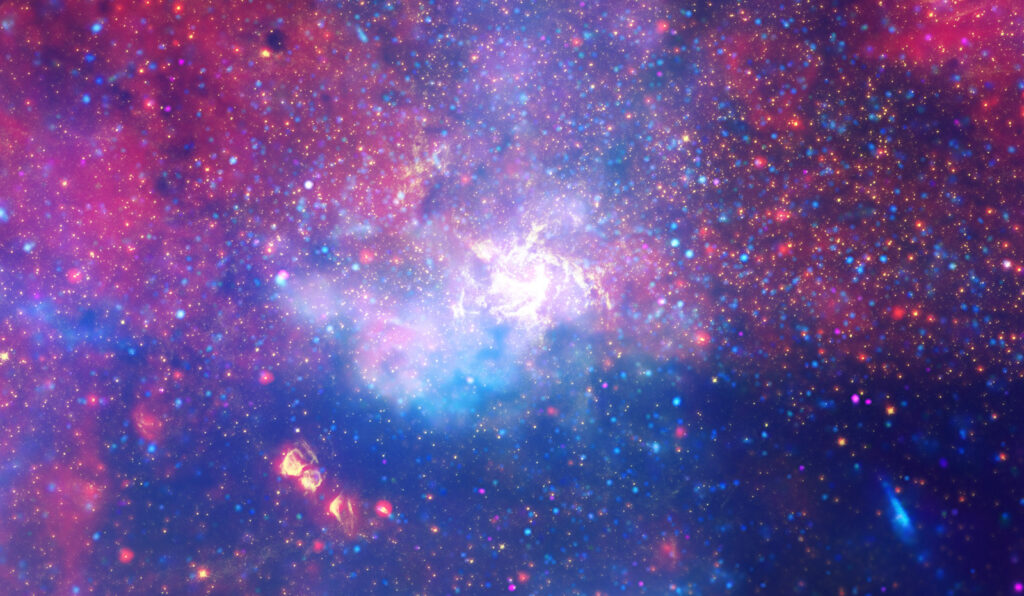
A mesmerizing swirl of searing hot gas comes to life in this multiwavelength composite image, brilliantly pinpointing the approximate location of the supermassive black hole known as Sagittarius A* (Photo Credit: NASA. ESA, SSC, CXC, STScI)
However, it wasn't until 1971 that scientists unraveled the mystery surrounding Cygnus X-1. Astronomers deduced that the enigmatic X-ray source originated from a brilliant blue star in a close orbit with a mysterious dark companion. This revelation led to the startling hypothesis that the observed X-rays were a consequence of the bright star's material being violently stripped away and devoured by the dark object—a voracious black hole.
One reason we don't see many pictures of black holes is that they're super tricky to photograph. Their gravity is so strong that it sucks in even light, making it nearly impossible to see them directly. So, scientists look at how stuff around possible black holes gets affected by them. They watch how nearby stars and clouds of gas move, and they detect X-rays or gamma rays coming from stuff falling into a black hole.
Formation
Black holes form through two distinct pathways. The first way they come into existence is by being the remnants of massive stars when those stars reach the end of their lives. When stars that are initially more massive, like 8 to 10 times the mass of our Sun or even more, run out of fuel, they go out in a spectacular explosion and then collapse, creating a super-dense object, which we call a black hole. The black hole left behind by this process is known as a stellar mass black hole and has a mass of just a few times that of the Sun. However, not all stars leave behind black holes when they die. Less massive stars become neutron stars or white dwarfs instead.
The second way that black holes form is quite different. They emerge directly from the collapse of gas, skipping the traditional star formation process. This method typically results in much larger black holes, with masses ranging from a thousand times the mass of our Sun up to an astonishing hundred thousand times the mass of the Sun. This particular process is believed to have been more common in the early universe and is responsible for creating the seeds of more massive black holes. Understanding these two different pathways to black hole formation helps us piece together the complex story of the universe and the variety of black holes it contains. It's like unraveling a cosmic mystery with two different clues that point to how these enigmatic objects come into being.
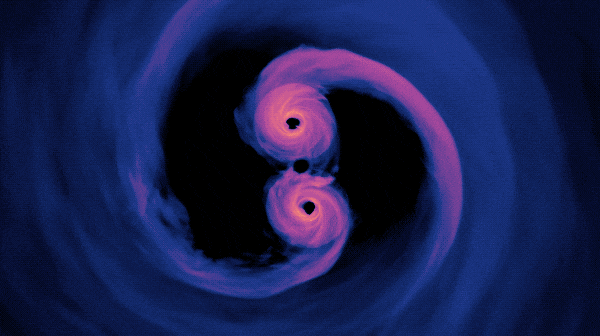
In this computer simulation of supermassive black holes, located just 40 orbits away from merging, the gas radiates with intense brightness. Such intricate models hold the promise of aiding scientists in the identification of actual instances of these formidable binary systems (Credit: NASA)
Types Of Black Holes
Stellar Black Holes
Stellar black holes, arising from the cataclysmic collapse of massive stars, represent a fascinating cosmic phenomenon. Unlike their supermassive cousins, these black holes are relatively small, but their density is nothing short of mind-boggling. Picture compressing over three times the mass of our sun into a space no larger than a typical city. This gravitational powerhouse exerts a powerful pull on everything in its vicinity. Stellar black holes don't just sit idly in space; they actively grow by voraciously consuming the surrounding dust and gas from their host galaxies, like cosmic vacuum cleaners. These celestial objects serve as a testament to the astonishing extremes of nature, where matter and gravity dance in a cosmic ballet.
Supermassive Black Holes
Supermassive black holes, on the other hand, occupy a dominant role at the core of most galaxies, including our very own Milky Way. These cosmic giants are distinguished by their sheer mass, which can be millions or even billions of times that of our sun. Astonishingly, they share a similar diameter with their smaller stellar counterparts, leading to the question: How do these colossal entities come into existence? Scientists have yet to arrive at a definitive answer, but they speculate that supermassive black holes accrue their extraordinary mass by feeding on the abundant reserves of dust and gas concentrated in the galactic center. This relentless accumulation process allows these cosmic titans to evolve into some of the most intriguing objects in the universe, profoundly shaping the galaxies they inhabit.
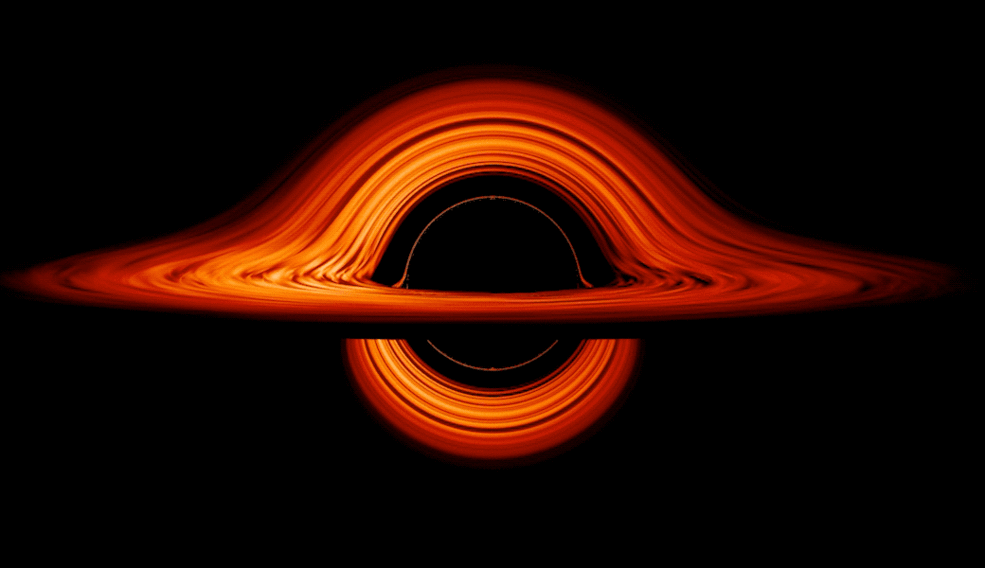
Seen nearly edgewise, the turbulent disk of gas churning around a black hole takes on a bizarre double-humped appearance. The black hole’s extreme gravity alters the paths of light coming from different parts of the disk, producing the warped image where we see the disk behind the black hole as if it is simultaneously on the top and the bottom of the black hole. (Credit: NASA’s Goddard Space Flight Center/Jeremy Schnittman_
Intermediate Black Holes
Until recently, the black hole family tree consisted of just two branches: small stellar black holes and colossal supermassive black holes. However, the discovery of intermediate-mass black holes (IMBHs) has added a tantalizing third dimension to this celestial lineage. IMBHs are midsize black holes that perplex scientists with their origin and behavior. They are thought to emerge when stars in a cluster collide in a spectacular cosmic chain reaction. Even more intriguing is the possibility that multiple IMBHs may converge in the heart of a galaxy, eventually giving rise to a supermassive black hole. Recent observations have suggested that these mysterious IMBHs may inhabit dwarf galaxies, further deepening the mystery surrounding them. It's as if these enigmatic black holes have remained elusive, like long-lost relatives who prefer to stay hidden from the cosmic spotlight. Recent research has hinted at their presence, with X-ray activity in some dwarf galaxies suggesting the existence of black holes with masses ranging from 36,000 to 316,000 times that of our sun. These findings have provided a glimpse into the previously uncharted territory of intermediate black holes, shedding light on their potential role in the cosmic tapestry. As we continue to explore and unravel the secrets of our universe, these black holes serve as captivating puzzles, challenging our understanding of the cosmos and fueling the human spirit of curiosity.
Einstein's Theory and Spacetime Curvature
Albert Einstein's theory of general relativity, a landmark achievement in the realm of physics, holds a critical position in our understanding of black holes. This groundbreaking theory, published in 1915, radically altered our comprehension of gravity and space-time, revealing that massive objects, such as stars, warp the very fabric of space-time around them. This warping effect is the root of gravity, drawing other objects towards these massive bodies. The significance of general relativity in the context of black holes cannot be overstated, especially when considering the supermassive black holes that reside at the heart of most galaxies. These colossal cosmic entities, with masses reaching millions or even billions of times that of our Sun, owe their existence to the gravitational dance choreographed by Einstein's equations. They warp space-time to such an extent that they not only trap everything, including light, within their grasp but also bend the paths of photons, creating striking visual phenomena.
As we embark on an ever-deepening journey into the enigmatic world of black holes, it becomes evident that Albert Einstein's profound insights continue to serve as our guiding star, illuminating the path to understanding these cosmic enigmas that defy the norms of the universe.
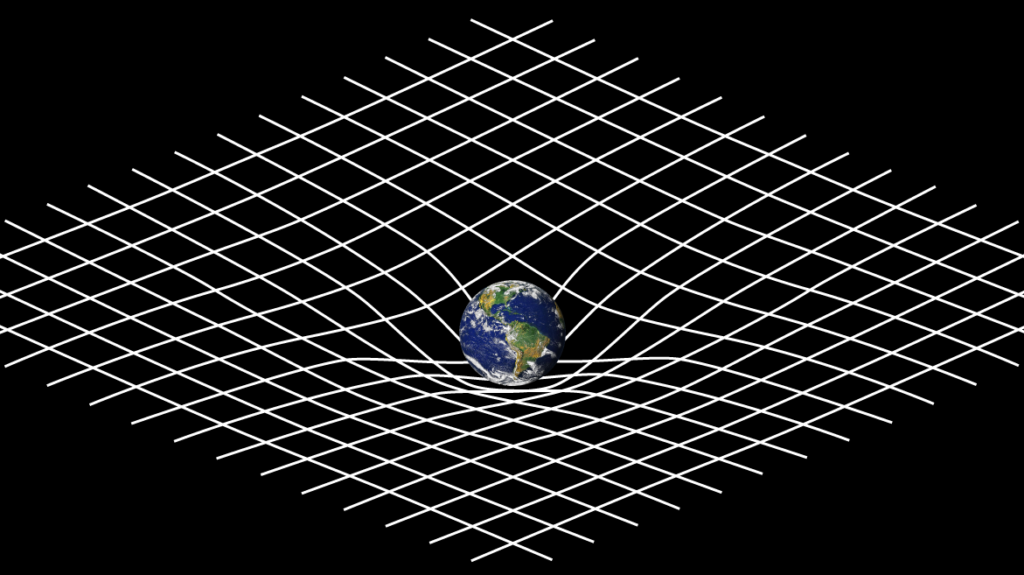
The image shows how Albert Einstein's theory of general relativity envisions space-time as a curved fabric due to the Earth's mass, explaining gravity's effects as objects naturally move along these curves (Photo Credit: NASA)
The Information Paradox and Hawking Radiation
The Information Paradox and Hawking Radiation are like a thrilling cosmic mystery that's puzzled scientists and space enthusiasts for quite some time. You see, Stephen Hawking suggested that black holes, those dark and mysterious cosmic whirlpools, aren't completely silent – they emit a faint radiation called Hawking radiation. This revelation turned some of our cosmic beliefs upside down and triggered a lively discussion about what happens to all the information that gets swallowed by black holes. It's like a cosmic riddle – does it disappear forever or find its way out somehow? This Hawking radiation thing implies that black holes, over time, slowly vanish into thin air, releasing information that was once thought to be gone for good. These mind-boggling ideas keep scientists on their toes as they strive to crack the code behind the Information Paradox and understand the secrets of Hawking radiation.
The Future of Black Hole Research
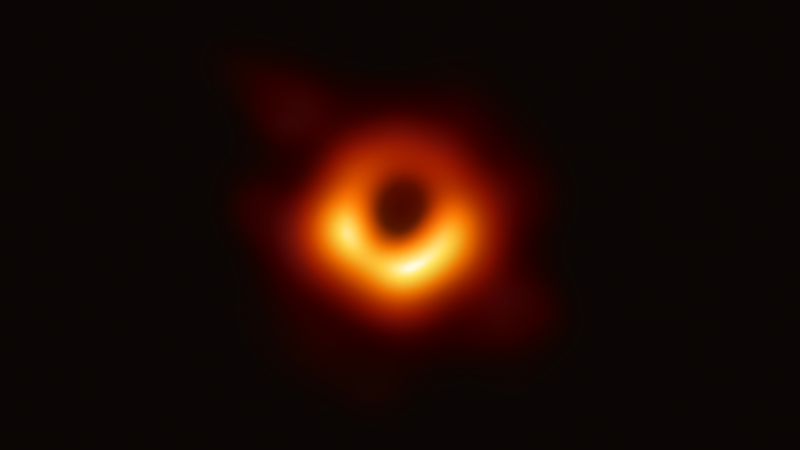
In 2019, a groundbreaking achievement in astrophysics marked the first-ever capture of a black hole on camera. It was taken by The Event Horizon Telescope
(Photo Credit: Event Horizon Telescope Collaboration)
The world of black hole research is undergoing a fascinating transformation, all thanks to the incredible leaps in observational technology and the growing role of artificial intelligence. While we've made some remarkable strides, it's important to note that there are still numerous mysteries waiting to be unraveled. With each new advancement in both our observation tools and the theoretical foundations of physics, we find ourselves edging closer to uncovering the hidden truths of these enigmatic cosmic entities. The pursuit of understanding black holes stands as a powerful testament to the enduring human spirit of curiosity and the unwavering dedication to expanding our knowledge, even when faced with the vast unknown.
"The message of this lecture is that black holes ain't as black as they are painted. They are not the eternal prisons they were once thought. Things can get out of a black hole, both to the outside and possibly to another universe. So, if you feel you are in a black hole, don't give up. There's a way out."-Stephen Hawking
Subscribe To Our Newsletter
Receive amazing space news and stories that are hot off the press and ready to be read by thousands of people all around the world.
